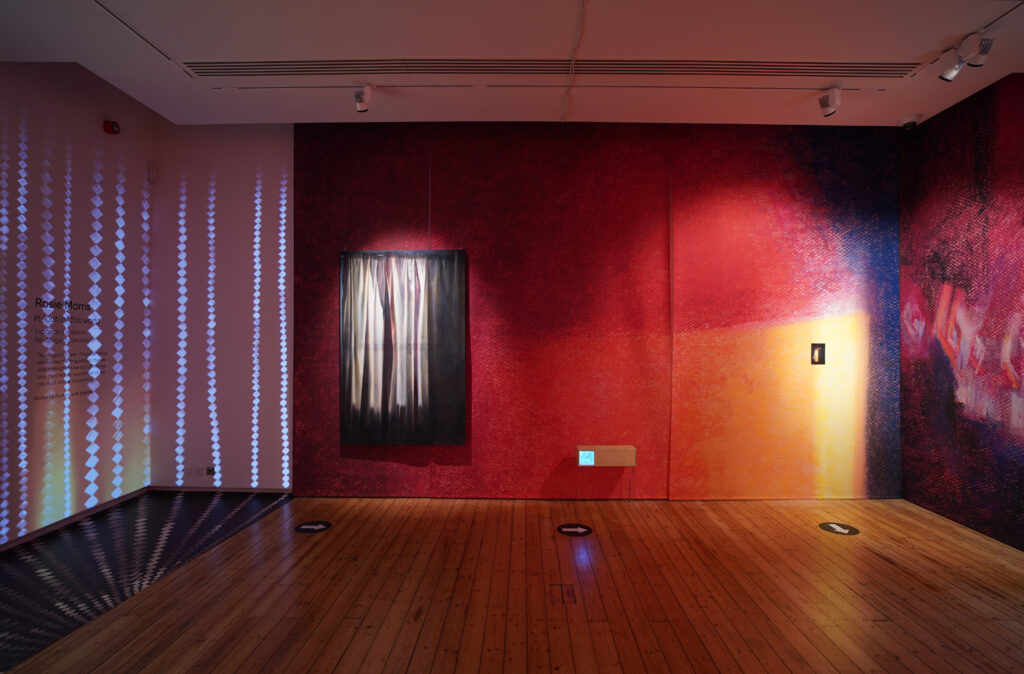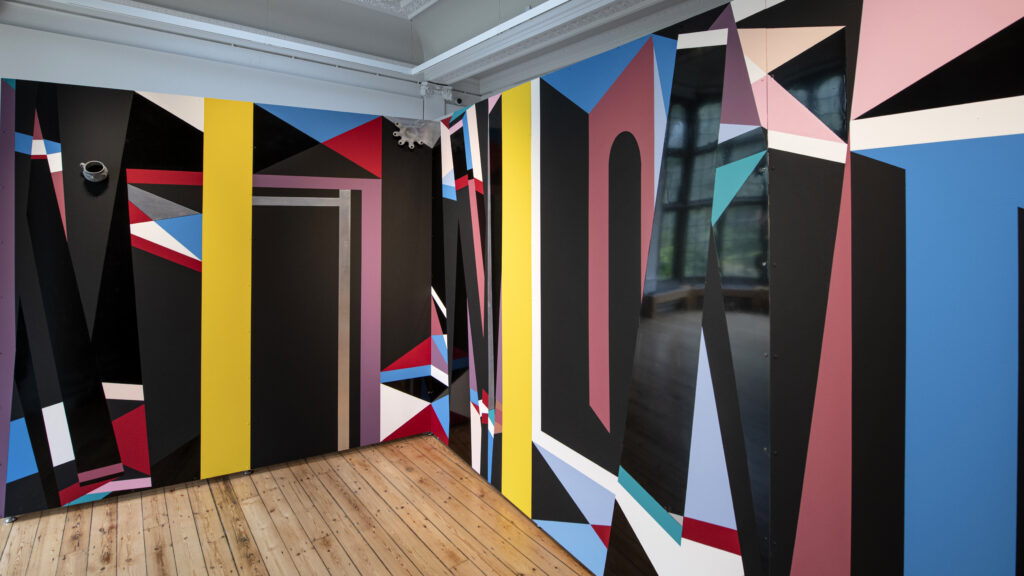Exhibition by Catrin Huber and Commission by Rosie Morris.
On entering the Hatton Gallery I was posed with a choice. There appeared to be two directions through the loop of rooms that make up this exhibition, and I chose to go left, moving backwards chronologically – or so it felt. Here began my navigation of the physical and conceptual layering of the show.
Rosie Morris’s In / out / of this world (2021) is a womb-like space, with the walls enveloped by floor to ceiling paper panels. The wall hangings are super-sized prints of soft pastel drawings – maybe even rubbings of a surface. The space feels simultaneously like a historical recreation of an interior and an immersive replication of a mild acid trip, or the effects of sleep deprivation. To one side of the room there is a dark square against the backdrop of wall hangings, it feels like the absence of a fireplace; a darkened hearth. The panels move gently as you circle the space.
Mounted against these warm paper sheets are three representations of spaces and thresholds: an oil painting of a curtained window, a photograph of a door ajar with light spilling from the room beyond, and an architectural model of a communal space. Each piece is softly illuminated against the comparative darkness of the gallery. They appear like repeated attempts at capturing the quiet domesticity of the last year, through varied methods and means.

Around the door that leads back to the gallery gift shop, a fan of interlinked diamond shapes spills from the floor and up the walls over print and projected light, ‘drawing from thresholds unburied abroad and paving your way closer to home’ says a disembodied narration, which is present in two forms in the handout written by the artists, and in the vinyl exhibition text extracting quotes from Huber’s fictional conversation. These unseen guides shape our experience of the show, giving us half answers and drawing our minds out of the space and into other lives. ‘What hidden histories mingle in all these breathing walls?’
Moving on, I discover Catrin Huber’s large, room-dominating structures, previously shown as site-responsive in their Roman locations. In the House of the Beautiful Courtyard in Herculaneum and the House of the Cryptoporticus in Pompeii, these works spoke to the audience and their surroundings in a particular way, and here we see further additions to the conversation. The entire Expanded Interiors project is a dialogue between the ancient and the contemporary.
Standing in their presence, it is hard to fathom their journey across land and sea to be here. The viewing experience asks us to construct and reconstruct the work across contexts.
These painting installations are considerable with a chunky presence, imposing in both their original Roman and their new sites. But equally, we see that the structures are self-supporting, and ask nothing of their surroundings. They do not need to be drilled or affixed, and therefore they interact lightly with history, leaving no trace. We glimpse their previously unseen reverse sides, revealing cryptic notes for installation and assembly as well as the sandbags and supports, and we are reminded, by the way in which these installations so stridently do not fit these specific spaces, that they had a previous life.

I am put in mind of a piece by Angela De La Cruz, called Larger Than Life, exhibited at PEER in London in 2016. The enormous 10×12 metre canvas, originally constructed for the Ballroom of the Royal Festival Hall in 1998, was seemingly snapped and squeezed into the 5×7.5 metre gallery. The piece was a farcical re-staging that emphasised the site-un-specificity of the work. Huber’s exhibition does something more – it continues a thought process in a new site, weaving in strands like the Roman-influenced architecture of the Hatton, the work of artist (and member of the research team) Rosie Morris, and the permanent exhibition of Kurt Schwitters’ Merz Barn Wall (1947-8).
Schwitters’ Merzbauten ‘were sculptural environments which could be physically entered and experienced in the round.’ He developed these works from the 1920s, and they became a key influence on contemporary artists after his death. I have walked past the piece several times before, picking up vaguely on its significance from the clear effort taken to transplant the work here, preserve it in the chill of the air conditioning, and present its history through an illustrated timeline. Until seeing this exhibition, which feels indebted to Schwitters, I had never taken the time to absorb the information fully. Schwitters is deftly brought into the world of the show through the inclusion of quotes about his art and process in the exhibition texts, which are then revealed to be fiction.
At every opportunity, the artists re-state the fiction and fabrication of the show: the assemblage of elements expands outwards, but we are constantly reminded of its flat terrain, helmed by Huber. We are not brushing up against any one true history – the installations hint at the Roman houses they inhabited, responding to and collapsing their shapes with layers of angled, coloured paint. The closest we get to the ancient walls is through the digital fabrication of Light Trap (2021) – an interactive walkthrough projected onto the wall and navigated via video game handset – even the Roman artefacts we encounter have been photographed or scanned and re-fabricated.
The impact of these devices is anything but flat. The confluence of the works, impressions, histories and narratives, is much greater than the sum of its parts. The 3D printed objects themselves send the mind in two directions. They recall the ceramics used by Roman armies, who left ‘traces of terracotta from the shores of Herculaneum to the forts of Hadrian’s Wall’1 but simultaneously we see the signs of their creation, printed line by line like an ancient face generated jerkily in a Time Team recreation.
It is obvious that both Huber and Schwitters recognise and take advantage of ‘the ability of collage and assemblage to create new relationships between objects, texts and images removed from their original context,’2 allowing both artists to develop their aims of bringing art into conversation with everyday life, and in the case of Huber, the lives of those across history.

As I sit in front of the Merz Barn Wall understanding its true history and provenance for the first time, I think about how fleeting and arbitrary so much of what we do is. In comparison to this artefact – moved painstakingly from a small outhouse in Ambleside – most of us drift into obscurity. Things only have value if people attribute value to them, historians and artists have great responsibility in shaping our understanding of what went before. This project provides a unique bridge between the practices of contemporary fine art and archaeology, allowing multi-directional insight.
When dipping our audience toes into the wealth of research undertaken through the Expanded Interiors project, I realise any initial misgivings I might have had – like the name being a bit broad or generic – dwindle in the presence of this body of work. The Expanded Interiors website indicates that the team covers a breadth of contemporary art, archaeology and digital technology, it also provides context through video and podcasts, and related resources. Like any large research project, the title conveys the huge amount of ground covered in the exploration of new knowledge. In this re-staging historical spaces are not just expanded, they’re borrowed, spliced with the present and transplanted; they’re extrapolated, and expanded upon.
While browsing the fifth room of the exhibition, I begin to tune into the voiceover floating over the physical and digital assemblage in the room. I recognise Fiona Anderson’s voice, she speaks of visiting Pompeii and Herculaneum with ‘both existing between devastation and restoration,’3 and of ‘the much-trodden historical path of the now-meets-then qualities of these two ruined towns, with their accidental practice of combining the strange with the familiar.’4 These snatches of personal yet academic reflections are a poignant addition to this most physically layered space.

The second audio piece sounds, at first, like a radio play. The disembodied voice mimics several accents in a fictional panel discussion between three artists (a woman Roman wall painter, Russian artist El Lissitzky and German artist Kurt Schwitters) who ‘discuss their respective historical practices and what these approaches might offer to contemporary site-specific practice, and to the interrelationship of art, architecture and life.’5 The conversation draws out strands of Huber’s research, cheekily presuming thought processes and adding opportunities for the artists to respectfully disagree and make each other laugh.
Huber’s Roman painter finishes the discussion with a quote that speaks closely to my experiences within the gallery, and the aims of the show at large.
‘I think that what our Roman practice brings to the discussion is firstly complexity; that is how our art articulated a whole building in a layered, yet coherent way, and secondly a trust and belief in the visual and intellectual capacities of the audience – and a recognition that challenging them is good.’6
Expanded Interiors previously challenged audiences in Herculaneum and Pompeii by bringing vibrant contemporary art into a heritage context. For this re-staging, that challenge has now been crafted into an invitation. We are brought into the research process, introduced to influences, assistants and imagined characters. The layers of the show are like the layers of soft velvet in the collection of fabric wall hangings displayed in the final room. Architectural shapes are delineated with machine stitched lines across monochrome materials. Shapes and sections are cut away to reveal another texture, hidden beneath, and a flash of neon can be seen from the reverse, adding a warm glow against the gallery wall.
To end this piece, I would like to return to the fictional Roman painter lightly mocking her male counterparts, and in the process hitting on a deep truth – ‘Complexity, difficulty and multi-layered-ness is the key to the future!’7
Expanded Interiors: Re-Staged Exhibition by Catrin Huber and Commission by Rosie Morris
Hatton Gallery Newcastle, 3 July – 10 August 2021
Grace Denton is an artist based in Newcastle upon Tyne.
This review is supported by The Hatton Gallery
1 Gallery interpretation leaflet
2 Extract from wall text in permanent Merz Barn Wall exhibition, Hatton Gallery
3 Anderson, F. 2019 We are rarely independent structures. Expanded Interiors at Herculaneum and Pompeii, Kerber, Bielefield / Berlin, 2019
4 Ibid
5 Huber, C, C. 2019. Art, Architecture and life: A fictional panel discussion. Expanded Interiors at Herculaneum and Pompeii, Kerber, Bielefield / Berlin, 2019
6 Ibid
7 Ibid
Published 27.08.2021 by Lesley Guy in Reviews
1,860 words
